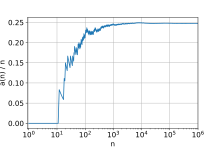| Revision as of 01:28, 28 October 2021 editMegaBat (talk | contribs)313 editsm →Properties: Fixed slight errorTag: 2017 wikitext editor← Previous edit |
Latest revision as of 11:55, 3 December 2024 edit undoD.Lazard (talk | contribs)Extended confirmed users33,845 editsm Reverted 1 edit by 83.151.251.71 (talk) to last revision by JayBeeEllTags: Twinkle Undo |
| (43 intermediate revisions by 28 users not shown) |
| Line 1: |
Line 1: |
|
{{short description|Number that is greater than the sum of its proper divisors}} |
|
{{short description|Number that is less than the sum of its proper divisors}} |
|
], of the abundance of the number 12]] |
|
], of the abundance of the number 12]] |
|
|
|
|
|
In ], an '''abundant number''' or '''excessive number''' is a number for which the sum of its ]s is greater than the number. The integer 12 is the first abundant number. Its proper divisors are 1, 2, 3, 4 and 6 for a total of 16. The amount by which the sum exceeds the number is the '''abundance'''. The number 12 has an abundance of 4, for example. |
|
In ], an '''abundant number''' or '''excessive number''' is a positive integer for which the sum of its ]s is greater than the number. The integer 12 is the first abundant number. Its proper divisors are 1, 2, 3, 4 and 6 for a total of 16. The amount by which the sum exceeds the number is the '''abundance'''. The number 12 has an abundance of 4, for example. |
|
|
|
|
|
==Definition== |
|
==Definition== |
|
A number ''n'' for which the sum of divisors ] > 2''n'', or, equivalently, the sum of proper divisors (or ]) ''s''(''n'') > ''n''. |
|
An ''abundant number'' is a ] {{math|''n''}} for which the ] {{math|''σ''(''n'')}} satisfies {{math|''σ''(''n'') > 2''n''}}, or, equivalently, the sum of proper divisors (or ]) {{math|''s''(''n'')}} satisfies {{math|''s''(''n'') > ''n''}}. |
|
|
|
|
|
Abundance is the value ''σ''(''n'') − ''2n'' (or ''s''(''n'') − ''n''). |
|
The ''abundance'' of a natural number is the ] {{math|''σ''(''n'') − ''2n''}} (equivalently, {{math|''s''(''n'') − ''n''}}). |
|
|
|
|
|
==Examples== |
|
==Examples== |
| Line 19: |
Line 19: |
|
==Properties== |
|
==Properties== |
|
*The smallest odd abundant number is 945. |
|
*The smallest odd abundant number is 945. |
|
*The smallest abundant number not divisible by 2 or by 3 is 5391411025 whose distinct ]s are 5, 7, 11, 13, 17, 19, 23, and 29 {{OEIS|id=A047802}}. An algorithm given by Iannucci in 2005 shows how to find the smallest abundant number not divisible by the first ''k'' ]s.<ref>{{citation|author=D. Iannucci|title=On the smallest abundant number not divisible by the first ''k'' primes|journal=]|volume=12|issue=1|year=2005|pages=39–44|url=http://projecteuclid.org/DPubS?service=UI&version=1.0&verb=Display&handle=euclid.bbms/1113318127}}</ref> If <math>A(k)</math> represents the smallest abundant number not divisible by the first ''k'' primes then for all <math>\epsilon>0</math> we have |
|
*The smallest abundant number not divisible by 2 or by 3 is 5391411025 whose distinct ]s are 5, 7, 11, 13, 17, 19, 23, and 29 {{OEIS|id=A047802}}. An algorithm given by Iannucci in 2005 shows how to find the smallest abundant number not divisible by the first ''k'' ]s.<ref>{{citation |author=D. Iannucci |title=On the smallest abundant number not divisible by the first ''k'' primes |journal=] |volume=12 |issue=1 |pages=39–44 |year=2005 |doi=10.36045/bbms/1113318127 |url=https://projecteuclid.org/journals/bulletin-of-the-belgian-mathematical-society-simon-stevin/volume-12/issue-1/On-the-smallest-abundant-number-not-divisible-by-the-first/10.36045/bbms/1113318127.full}}</ref> If <math>A(k)</math> represents the smallest abundant number not divisible by the first ''k'' primes then for all <math>\epsilon>0</math> we have |
|
::<math> (1-\epsilon)(k\ln k)^{2-\epsilon}<\ln A(k)<(1+\epsilon)(k\ln k)^{2+\epsilon} </math> |
|
::<math> (1-\epsilon)(k\ln k)^{2-\epsilon}<\ln A(k)<(1+\epsilon)(k\ln k)^{2+\epsilon} </math> |
|
:for sufficiently large ''k''. |
|
:for sufficiently large ''k''. |
| Line 25: |
Line 25: |
|
*Every multiple of an abundant number is abundant.<ref name=Tat134/> For example, every multiple of 20 (including 20 itself) is abundant because <math>\tfrac{n}{2} + \tfrac{n}{4} + \tfrac{n}{5} + \tfrac{n}{10} + \tfrac{n}{20}= n + \tfrac{n}{10}.</math> |
|
*Every multiple of an abundant number is abundant.<ref name=Tat134/> For example, every multiple of 20 (including 20 itself) is abundant because <math>\tfrac{n}{2} + \tfrac{n}{4} + \tfrac{n}{5} + \tfrac{n}{10} + \tfrac{n}{20}= n + \tfrac{n}{10}.</math> |
|
* Consequently, infinitely many ] abundant numbers exist. |
|
* Consequently, infinitely many ] abundant numbers exist. |
|
|
] |
|
*Furthermore, the set of abundant numbers has a non-zero ].<ref name=HT95>{{cite book | zbl=0653.10001 | last1=Hall | first1=Richard R. | last2= Tenenbaum | first2=Gérald | author2-link=Gérald Tenenbaum | title=Divisors | series=Cambridge Tracts in Mathematics | volume=90 | location =Cambridge | publisher=] | year=1988 | isbn=978-0-521-34056-4 | page=95 }}</ref> Marc Deléglise showed in 1998 that the natural density of the set of abundant numbers and perfect numbers is between 0.2474 and 0.2480.<ref name=Del1998>{{cite journal | first=Marc | last=Deléglise | title= Bounds for the density of abundant integers | journal=Experimental Mathematics | volume=7 | issue=2 | year=1998 | pages=137–143 | url= http://projecteuclid.org/euclid.em/1048515661 | mr=1677091 | zbl=0923.11127 | issn=1058-6458 | doi=10.1080/10586458.1998.10504363| citeseerx = 10.1.1.36.8272 }}</ref> |
|
*Furthermore, the set of abundant numbers has a non-zero ].<ref name=HT95>{{cite book | zbl=0653.10001 | last1=Hall | first1=Richard R. | last2= Tenenbaum | first2=Gérald | author2-link=Gérald Tenenbaum | title=Divisors | series=Cambridge Tracts in Mathematics | volume=90 | location =Cambridge | publisher=] | year=1988 | isbn=978-0-521-34056-4 | page=95 }}</ref> Marc Deléglise showed in 1998 that the natural density of the set of abundant numbers and perfect numbers is between 0.2474 and 0.2480.<ref name=Del1998>{{cite journal | first=Marc | last=Deléglise | title= Bounds for the density of abundant integers | journal=Experimental Mathematics | volume=7 | issue=2 | year=1998 | pages=137–143 | url= http://projecteuclid.org/euclid.em/1048515661 | mr=1677091 | zbl=0923.11127 | issn=1058-6458 | doi=10.1080/10586458.1998.10504363| citeseerx = 10.1.1.36.8272 }}</ref> |
|
* An abundant number which is not the multiple of an abundant number or perfect number (i.e. all its proper divisors are deficient) is called a ] |
|
* An abundant number which is not the multiple of an abundant number or perfect number (i.e. all its proper divisors are deficient) is called a ] |
|
* An abundant number whose abundance is greater than any lower number is called a highly abundant number, and one whose relative abundance (i.e. s(n)/n ) is greater than any lower number is called a ] |
|
* An abundant number whose abundance is greater than any lower number is called a highly abundant number, and one whose relative abundance (i.e. s(n)/n ) is greater than any lower number is called a ] |
|
*Every ] greater than 20161 can be written as the sum of two abundant numbers.<ref>{{Cite OEIS|sequencenumber=A048242|name=Numbers that are not the sum of two abundant numbers}}</ref> |
|
*Every ] greater than 20161 can be written as the sum of two abundant numbers. The largest even number that is not the sum of two abundant numbers is 46.<ref>{{Cite OEIS|sequencenumber=A048242|name=Numbers that are not the sum of two abundant numbers}}</ref> |
|
*An abundant number which is not a ] is called a ].<ref name=Tat144>Tatersall (2005) p.144</ref> An abundant number with abundance 1 is called a ], although none have yet been found. |
|
*An abundant number which is not a ] is called a ].<ref name=Tat144>Tattersall (2005) p.144</ref> An abundant number with abundance 1 is called a ], although none have yet been found. |
|
|
*Every abundant number is a multiple of either a perfect number or a primitive abundant number. |
|
|
|
|
|
==Related concepts== |
|
==Related concepts== |
| Line 41: |
Line 43: |
|
The smallest odd integer with abundancy index exceeding 3 is 1018976683725 = 3<sup>3</sup> × 5<sup>2</sup> × 7<sup>2</sup> × 11 × 13 × 17 × 19 × 23 × 29.<ref>For smallest odd integer ''k'' with abundancy index exceeding ''n'', see {{Cite OEIS|sequencenumber=A119240|name=Least odd number ''k'' such that sigma(k)/k >= n.}}</ref> |
|
The smallest odd integer with abundancy index exceeding 3 is 1018976683725 = 3<sup>3</sup> × 5<sup>2</sup> × 7<sup>2</sup> × 11 × 13 × 17 × 19 × 23 × 29.<ref>For smallest odd integer ''k'' with abundancy index exceeding ''n'', see {{Cite OEIS|sequencenumber=A119240|name=Least odd number ''k'' such that sigma(k)/k >= n.}}</ref> |
|
|
|
|
|
If '''p''' = (''p''<sub>1</sub>, ..., ''p<sub>n</sub>'') is a list of primes, then '''p''' is termed ''abundant'' if some integer composed only of primes in '''p''' is abundant. A necessary and sufficient condition for this is that the product of ''p<sub>i</sub>''/(''p<sub>i</sub>'' − 1) be > 2.<ref>{{cite journal | title = Sums of divisors and Egyptian fractions | last = Friedman | first = Charles N. | journal = ] | year = 1993 | volume = 44 | pages = 328–339 | url = http://dell5.ma.utexas.edu/users/friedman/divisors.ps | mr = 1233293 | zbl = 0781.11015 | doi = 10.1006/jnth.1993.1057 | issue = 3 | access-date = 2012-09-29 | archive-url = https://web.archive.org/web/20120210165648/http://dell5.ma.utexas.edu/users/friedman/divisors.ps | archive-date = 2012-02-10 | url-status = dead | doi-access = free }}</ref> |
|
If '''p''' = (''p''<sub>1</sub>, ..., ''p<sub>n</sub>'') is a list of primes, then '''p''' is termed ''abundant'' if some integer composed only of primes in '''p''' is abundant. A necessary and sufficient condition for this is that the product of ''p<sub>i</sub>''/(''p<sub>i</sub>'' − 1) be > 2.<ref>{{cite journal | title = Sums of divisors and Egyptian fractions | last = Friedman | first = Charles N. | journal = ] | year = 1993 | volume = 44 | pages = 328–339 | mr = 1233293 | zbl = 0781.11015 | doi = 10.1006/jnth.1993.1057 | issue = 3 | doi-access = free }}</ref> |
|
|
|
|
|
== References == |
|
== References == |
For example, the proper divisors of 24 are 1, 2, 3, 4, 6, 8, and 12, whose sum is 36. Because 36 is greater than 24, the number 24 is abundant. Its abundance is 36 − 24 = 12.
Numbers whose sum of proper factors equals the number itself (such as 6 and 28) are called perfect numbers, while numbers whose sum of proper factors is less than the number itself are called deficient numbers. The first known classification of numbers as deficient, perfect or abundant was by Nicomachus in his Introductio Arithmetica (circa 100 AD), which described abundant numbers as like deformed animals with too many limbs.
The smallest odd integer with abundancy index exceeding 3 is 1018976683725 = 3 × 5 × 7 × 11 × 13 × 17 × 19 × 23 × 29.




 represents the smallest abundant number not divisible by the first k primes then for all
represents the smallest abundant number not divisible by the first k primes then for all  we have
we have


 be the number of abundant numbers not exceeding
be the number of abundant numbers not exceeding  . Plot of
. Plot of  for
for  (with
(with